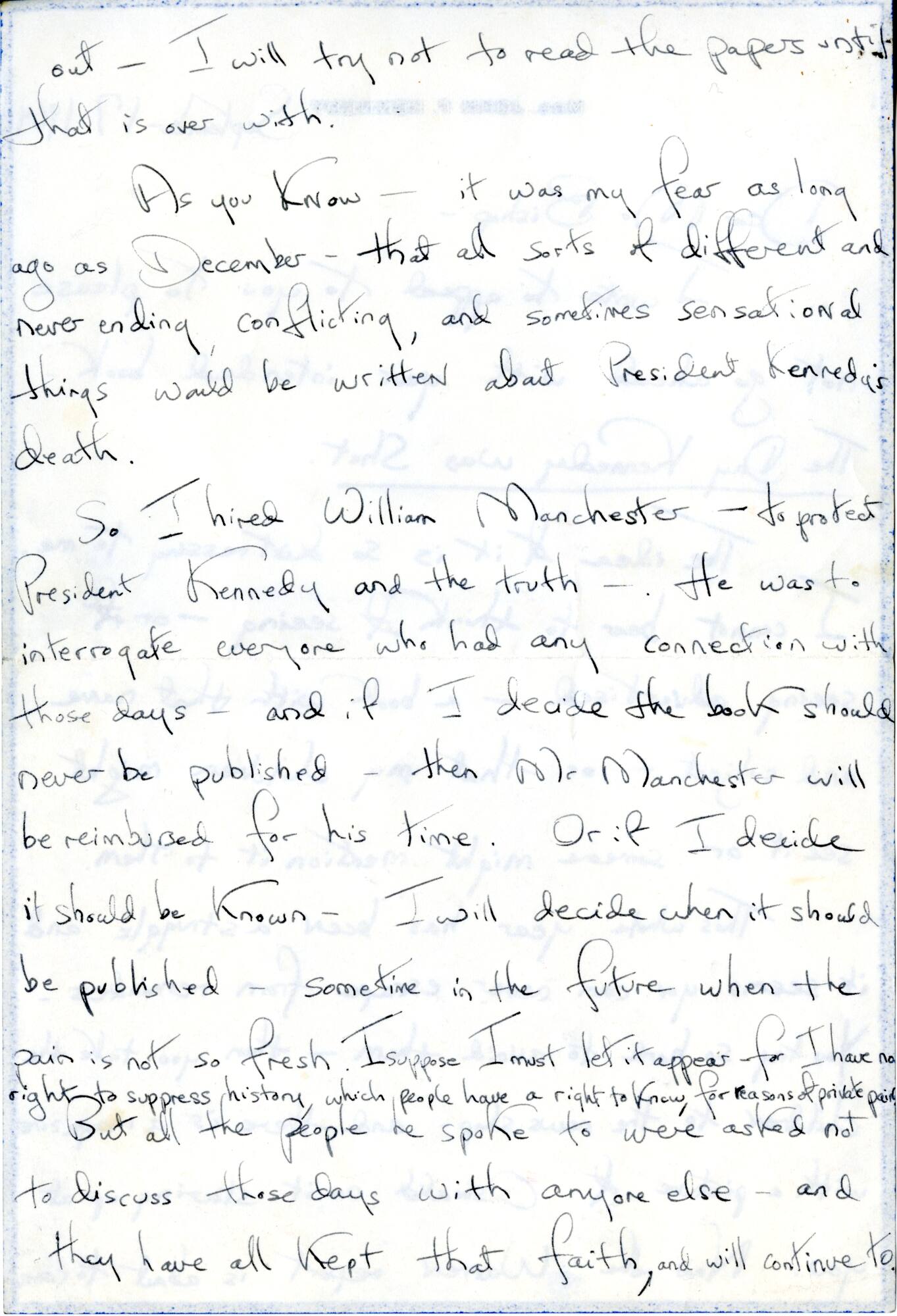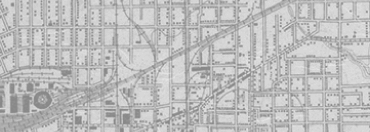


Back
Handwritten letter from Jacqueline Kennedy to Jim Bishop
Handwritten letter from Jacqueline Kennedy to Jim Bishop written on September 17, 1964 in which she asks Bishop not to write about the assassination of President Kennedy. The letter is two pages front and back and is on letterhead that reads "Mrs. John F. Kennedy" in black printed text. The body of the letter is written in blue and black ink with a black border around the edge of the front of the pages. In the letter Jacqueline Kennedy argues that Mr. Bishop's proposed book, "The Day Kennedy Was Shot," would not add anything new to the story given that she had already hired William Manchester to write the definitive account of the assassination and to "protect President Kennedy and the truth." She planned to control when and how Manchester’s book, "The Death of a President," would be released. Combined with the soon to be released Warren Commission report, Jacqueline Kennedy felt there would be nothing more to say and that Mr. Bishop's book would only cause more suffering and pain. In conclusion, she pleaded with Bishop to respect her feelings and not go ahead with the publication of his book. After selecting noted author William Manchester to write his account, she was unwilling to accept the idea that any other books would be published on the subject. Jacqueline Kennedy was accustomed to carefully crafting and controlling the public image of her family, and ultimately, she recognized the importance of trying to control the story of President Kennedy's death and legacy.
Handwritten letter from Jacqueline Kennedy to Jim Bishop
09/17/1964
Paper; Ink, Pen
9 1/4 × 6 1/4 in. (23.5 × 15.9 cm)
The Sixth Floor Museum at Dealey Plaza Collection
2018.071.0001
Despite Mrs. Kennedy's objections, Jim Bishop proceeded with his book, The Day Kennedy Was Shot, which was published in 1968. - Stephanie Allen-Givens, Collections and Exhibits Manager
Jim Bishop (1907-87) started his journalistic career at the New York Daily Mirror in 1930. He would go on to serve as associate editor of Collier's Magazine, executive editor of Liberty Magazine and a longtime columnist with King Features Syndicate, though by the 1950s he was primarily recognized as a best-selling author. In addition to a series of religious titles, his 1955 examination of the Lincoln assassination, The Day Lincoln Was Shot, sold more than 3 million copies. He continued his focus on the presidency the following year with a Cosmopolitan article, "A Day with Dwight D. Eisenhower." He had just completed the manuscript for the book, A Day in the Life of President Kennedy, ten days before the assassination. The book was published the following year and was one of the top ten books in sales for 1964. A follow-up title, A Day in the Life of President Johnson, was published in 1967. Some four years after his correspondence with Mrs. Kennedy, Bishop's The Day Kennedy Was Shot was finally published in 1968. As of 2020, the book remains in print more than half a century later. - Stephen Fagin, Curator

Handwritten letter from Jacqueline Kennedy to Jim Bishop
Handwritten letter from Jacqueline Kennedy to Jim Bishop written on September 17, 1964 in which she asks Bishop not to write about the assassination of President Kennedy. The letter is two pages front and back and is on letterhead that reads "Mrs. John F. Kennedy" in black printed text. The body of the letter is written in blue and black ink with a black border around the edge of the front of the pages. In the letter Jacqueline Kennedy argues that Mr. Bishop's proposed book, "The Day Kennedy Was Shot," would not add anything new to the story given that she had already hired William Manchester to write the definitive account of the assassination and to "protect President Kennedy and the truth." She planned to control when and how Manchester’s book, "The Death of a President," would be released. Combined with the soon to be released Warren Commission report, Jacqueline Kennedy felt there would be nothing more to say and that Mr. Bishop's book would only cause more suffering and pain. In conclusion, she pleaded with Bishop to respect her feelings and not go ahead with the publication of his book. After selecting noted author William Manchester to write his account, she was unwilling to accept the idea that any other books would be published on the subject. Jacqueline Kennedy was accustomed to carefully crafting and controlling the public image of her family, and ultimately, she recognized the importance of trying to control the story of President Kennedy's death and legacy.
Handwritten letter from Jacqueline Kennedy to Jim Bishop
09/17/1964
Letters
Letterhead
Author
Kennedy, Jacqueline
Bishop, Jim
Manchester, William
Kennedy, John F.
Warren Report
Warren Commission
New York
Paper; Ink, Pen
9 1/4 × 6 1/4 in. (23.5 × 15.9 cm)
The Sixth Floor Museum at Dealey Plaza Collection
2018.071.0001
Despite Mrs. Kennedy's objections, Jim Bishop proceeded with his book, The Day Kennedy Was Shot, which was published in 1968. - Stephanie Allen-Givens, Collections and Exhibits Manager
Jim Bishop (1907-87) started his journalistic career at the New York Daily Mirror in 1930. He would go on to serve as associate editor of Collier's Magazine, executive editor of Liberty Magazine and a longtime columnist with King Features Syndicate, though by the 1950s he was primarily recognized as a best-selling author. In addition to a series of religious titles, his 1955 examination of the Lincoln assassination, The Day Lincoln Was Shot, sold more than 3 million copies. He continued his focus on the presidency the following year with a Cosmopolitan article, "A Day with Dwight D. Eisenhower." He had just completed the manuscript for the book, A Day in the Life of President Kennedy, ten days before the assassination. The book was published the following year and was one of the top ten books in sales for 1964. A follow-up title, A Day in the Life of President Johnson, was published in 1967. Some four years after his correspondence with Mrs. Kennedy, Bishop's The Day Kennedy Was Shot was finally published in 1968. As of 2020, the book remains in print more than half a century later. - Stephen Fagin, Curator
















